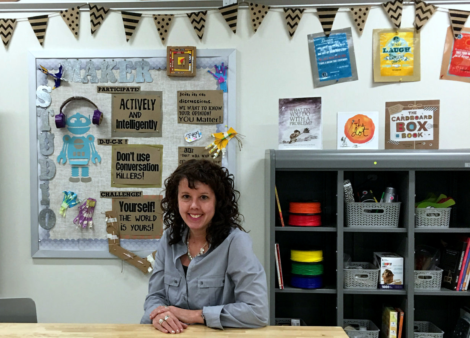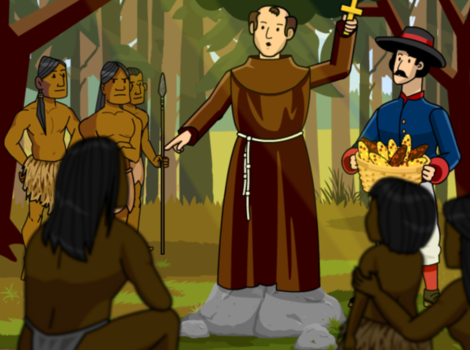
BrainPOP & Classroom Research
Posted by Dana Burnell on
Earlier this month, we introduced you to Elizabeth Eastman, June’s featured Certified BrainPOP Educator. In her second post, Elizabeth shares how to best utilize BrainPOP and its features in the research process. Read on for her detailed reflection and ideas about how you can best put our tools to use with your students.
Designing inquiry-based research projects for students establishes a foundation of critical skills. When students envision themselves as researchers, they are empowered to answer questions they have. Research can spark a sense of wonder and curiosity. The research process also creates a context to apply the integrated literacies of reading, writing and speaking. Students can engage with experts and collaborate with peers. They learn that understanding will be developed from many ideas pulled from multiple sources. They are empowered to become original content creators, collaborators and communicators. When research is paired with BrainPOP, the sky’s the limit! There are so many potential ways to integrate BrainPOP resources and tools to fuel research investigations.
Though all students are asked to do research throughout their educational experiences, they are not always taught HOW. Students may find the experience stressful and frustrating. Teachers may find it chaotic and difficult too. Choosing a topic and developing guiding questions can be daunting. Students must be armed with strategies to take notes and know how to avoid plagiarism as well as be prepared to use a critical mindset as they evaluate information. Goal-setting and goal-evaluation are key elements in time-management of projects. A concrete approach to organize notes with new information and ideas is fundamental to success. The Independent Investigation Method, otherwise known as the IIM Research process is a scaffolded approach to classroom research in 7 manageable steps. All teachers on my K-6 campus are have been trained to use this process in the classroom, so our students are becoming increasingly proficient and independent researchers as it is used with consistency from grade to grade. Common pitfalls and obstacles to successful classroom research are taken out of the equation with IIM! Outlined next are the steps in the IIM process itself along with a myriad number of ways BrainPOP pieces fit into the puzzle of classroom research.
STEP 1: TOPIC [Choose What To Study]
What do you already know? What do you want to find out? Choosing what to study aligns with grade-level standards, and research may be guided as a whole group, small group or by individual students as grade-level and developmentally appropriate. Initially, to provoke interest and curiosity, students need opportunities to experience immersion activities and to activate and build upon their prior knowledge in a given area of study. Once students have some prior experiences, they will be at a launch point to begin to choose and narrow topics. There are lots of flexible idea-mapping strategies. One way to begin is with a whole-class concept map which can become a jumping off point for generating topics for students’ independent research. By brainstorming prior knowledge and generating questions of interest, we are able to map out what we collectively know and what we want to find out. This is followed by an effort to organize and web ideas and questions into concept map categories which can then be narrowed down toward topic selection. Concept Mapping with BrainPOP and BrainPOP Jr. tools take this stage of the process to the next level! Students can explore how concept maps work as a way to represent one’s understanding of a topic through BrainPOP’s explanatory movie clips. Students learn how the things they know and along with new ideas they’re learning can be linked and cross-linked. They can develop their own concept maps with ‘Make-a-Map’ tool (embedded to the right of every BrainPOP movie clip) by adding images, keywords, movie snippets and color-coded descriptions. They may also find other uses for concept-mapping throughout their research investigation such as brainstorming and project planning. [Learn more with BrainPOP Educators Make-a-Map Teaching Resources. ]
STEP 2: GOAL-SETTING [Make a Plan]
What are the goals and requirements for the project? Students create an action plan for their research study. They define number and types of sources to be used. Students develop questions that relate to the essential and guiding questions framing the study that will require critical thinking and allow students to form original ideas instead of predetermined answers. Their questions direct research, and measurable goals are set for notefacts and new glossary words to be gathered. Question cubes or wheels and question starters from Bloom’s Taxonomy can be used to help students generate a range of question types.
In addition, students learn to identify types of plagiarism and reasons why some fall into this trap. Students can explore the topic of Plagiarism on BrainPOP in depth through several access points. Learning resources that complement the movie clip include primary source images and a written letter to prompt students’ critical thinking about evidence of plagiarism. ‘Related Reading’ lays out real life examples of plagiarism and gives kids some historical context. In GAME UP, The Meaning of Beep game allows kids to learn through game play and is Snap Thought enabled for reflective thinking. Students may also ‘Make-a-Map’ to represent their experiences with plagiarism, or they might create public service announcements advocating against it with ‘Make-a-Movie.’
STEP 3: RESEARCH [Discover the Facts]
While students learn about plagiarism, they also learn strategies to avoid it. An emphasis is placed on the ethics of research. Writing ‘notefacts’ by learning to paraphrase is a key strategy. New notes must relate to ‘Goal-Setting’ questions. They can also write ‘observation,’ ‘new idea’ or ‘opinion’ beside notefacts to distinguish facts from to connections to other ideas or opinions. Along the way, sources are documented and new vocabulary is listed in students’ individual glossaries.
There are a wealth of research resources offering guidance and instructional support on critical aspects of the research process in BrainPOP. Primary sources are readily accessible to student researchers so they can vividly experience areas of study firsthand! They can listen to an excerpt of John F. Kennedy’s inaugural address or view footage of the final launch of Space Shuttle Discovery for example. Note the ‘Primary Source’ tile to the right of many BrainPOP movies. There are useful graphic organizers included to guide students to observe, infer and to draw conclusions. In the Note-Taking Skills clip, kids see the process of breaking down information into main points, key ideas and relevant connections in different note-taking formats. Support for researchers to be better able to express ideas in their own words and to avoid plagiarism can be found in this clip about Paraphrasing. Kids can work with the interactive Cornell Notes chart for any BrainPOP movie for more independent practice. Students can also conduct an interview of a classmate and playback paraphrased notes to check if relevant facts were paraphrased and recorded as another strategy. Take a look at the embedded primary source recording of Bruce Lee’s interview and engage in a critique of the interviewer beforehand. Becoming more effective and specific with Internet Search is an important skillset too, and Search Shark game in GameUp extends students’ search skills further through game play. Evaluating Online Sources for accuracy, currency, and bias is outlined for students too as well as the necessity for Citing Sources.
STEP 4: ORGANIZING [ Build a Framework from Notes]
During this phase, students take their ‘messy’ note-taking process and regroup information from multiple sources into categories using initial essential or guiding questions. First, the teacher models re-reading notes and explaining reasoning for category choices. Students learn to reread notefacts and make meaningful connections among them in order to identify categories. Then students sort, cut and paste. By physically cutting apart and manipulating notes into categories, students can make new connections and create new knowledge from information gathered. Once sorted, students can paste onto IIM organizing sheets or build an outline from a frame provide by the teacher. The ‘Related Reading’ section connected to to the BrainPOP ‘Outlines’ clip makes a clear analogy relating computer file organization to organizing information into an outline to help students to understand levels and sublevels of hierarchies. When research organization is accomplished, students can then begin to analyze and interpret findings toward a final product and presentation.
STEP 5: GOAL-EVALUATION [Check Your Progress]
How did you do when you look back at Step 2? Goal Evaluation is a short but key step to be sure goals set by students at the beginning of the research study have been met. Where are the gaps and holes based on your research plan? Did you answer all your questions? Did you gather and organize sufficient information? Can you use new vocabulary you added to your research glossary? This is a chance for students to summarize key findings and evaluate the quality of their work. Then they move forward in the process or identify areas to refocus.
STEP 6: PRODUCT [Create Something New!]
Once an audience has been identified, students plan, design and create a final product type to share new knowledge. They write about and prepare to share what was learned. New understandings are transformed into diverse creative products using a variety of writing styles, skills and technology. Writing a summarization of research can take diverse forms–from expository to narrative format types. Writing that requires understanding of notes and eliminates plagiarism such as poetry, news reports, persuasive writing are worthwhile options. Products vary by audience and learning modalities. Students with teacher guidance will identify tools and resources needed and make a plan. Standards of quality are set with a rubric.
Step 7: PRESENTATION [Showtime!]
Students prepare and practice speaking and listening skills for a final presentation. Students strive to use speaking strategies correctly including eye contact, voice tone, volume and pace. They also listen attentively to others’ presentations to learn from them by asking relevant questions and recording observations.
For the final two stages of the research process, consider providing students the opportunity ‘Make-a-Movie’ with BrainPOP! This tool offers students an excellent way to demonstrate their depth of knowledge acquired through research. Choose whether or not to begin with a BrainPOP-style letter introduction to adopt the narrative style of BrainPOP movies they are all familiar with for their own digital storytelling projects. Students work through the creation process beginning with planning and storyboarding. They may choose to use ‘Make-a-Map’ as one storyboarding possibility among others. To produce movie scenes, students may include BrainPOP images or their own drawings as well as record sound narration.They can customize backgrounds and scene transitions. With individual accounts now in ‘My BrainPOP,’ teachers can track students’ work and provide feedback along the way. Writing and collaborating to communicate the story of their learning through movie-making is a challenging and creative culmination of the research journey![Learn more with BrainPOP Educators Make-a-Movie Teaching Resources ]
Inquiry-based research projects are both challenging and rewarding. By integrating these BrainPOP tools and resources seamlessly throughout the process, we can empower students to to make sense of the world by pursuing knowledge in response to their questions. Through inquiry-based research, we can develop information literate content creators, collaborators and communicators. Are there other ways are you using BrainPOP to fuel student inquiry and research? Please comment here and share!














